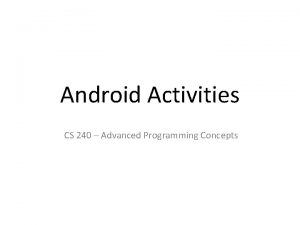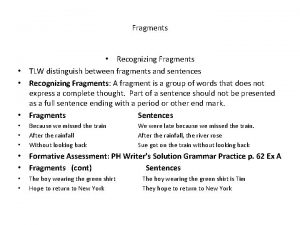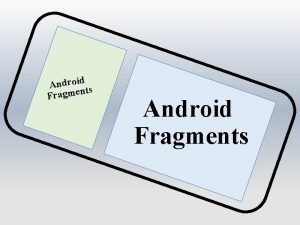Android Fragments CS 240 Advanced Programming Concepts Fragments










- Slides: 10

Android Fragments CS 240 – Advanced Programming Concepts

Fragments • Reusable pieces of UI • Layouts are already reusable, but fragments allow you to reuse the entire UI (including event handlers, etc. ) • Must be hosted by (displayed in) Activities • Placed inside a Frame. Layout • Use the Fragment. Manager class to place a fragment in a Frame. Layout of an Activity 2

The Fragment Lifecycle • Fragments have a lifecycle similar to activities • Restore saved instance state in on. Create(Bundle) or on. Create. View(Bundle) • Save instance sate in on. Save. Instance. State(Bundle) (same as Activity) • Inflate the view in on. Create. View(…) 3

on. Save. Instance. State(Bundle) Additional Info: https: //developer. android. com/guide/components/fragments 4

Create a Fragment in an Activity @Override protected void on. Create(Bundle saved. Instance. State) { super. on. Create(saved. Instance. State); set. Content. View(R. layout. activity_order_info); . . . } Fragment. Manager fm = this. get. Support. Fragment. Manager(); shipping. Address. Fragment = (Address. Fragment) fm. find. Fragment. By. Id(R. id. shipping. Frame. Layout); if (shipping. Address. Fragment == null) { shipping. Address. Fragment = create. Address. Fragment(get. String(R. string. shipping. Address. Title)); fm. begin. Transaction(). add(R. id. shipping. Frame. Layout, shipping. Address. Fragment). commit(); } • Above code is in the hosting activity • R. id. shipping. Frame. Layout is the ID of the Frame. Layout we add the fragment • Example: Fragment. Example/Order. Info. Activity. java 5

Create a Fragment in an Activity private Address. Fragment create. Address. Fragment(String title) { Address. Fragment fragment = new Address. Fragment(); Bundle args = new Bundle(); args. put. String(Address. Fragment. ARG_TITLE, title); fragment. set. Arguments(args); } return fragment; 6

Inflate View in on. Create. View(…) • Fragments inflate their view in on. Create. View(…) @Override public View on. Create. View(@Non. Null Layout. Inflater inflater, View. Group container, Bundle saved. Instance. State) { View view = inflater. inflate(R. layout. fragment_address, container, false); Text. View title. Text. View = view. find. View. By. Id(R. id. title. Text. View); title. Text. View. set. Text(title); street. Edit. Text = view. find. View. By. Id(R. id. street. Edit. Text); city. Edit. Text = view. find. View. By. Id(R. id. city. Edit. Text); state. Edit. Text = view. find. View. By. Id(R. id. state. Edit. Text); zip. Code. Edit. Text = view. find. View. By. Id(R. id. zip. Code. Edit. Text); } return view; Always set to false. This would only be set to true if you were generating and connecting view objects in code (which is never recommended). 7

Passing Data to a Fragment • Fragments shouldn’t depend on a specific activity, so they shouldn’t access their hosting fragment’s data directly • Two main steps to pass data to a fragment: 1. Pass an intent extra when starting the hosting activity 2. The hosting activity passes the data to the fragment when it creates the fragment 8

Passing Data to a Fragment Example (Criminal. Intent-Chapt 10) 1. Pass an intent extra when starting the hosting activity • Crime. List. Fragment. Crime. Holder. on. Click() 2. The hosting activity retrieves the data from it’s intent • • Crime. Activity. create. Fragment() Single. Fragment. Activity. on. Create(Bundle) 3. The hosting activity stashes the data in a Bundle, creates the fragment and attaches the bundle to the fragment • Crime. Activity. create. Fragment() 4. The fragment retrieves the data from it’s arguments bundle • Crime. Fragment. on. Create(Bundle) 9

Applications to Family Map Client • Main. Activity. on. Create(…) – Add Login. Fragment if user not logged in – Add Map. Fragment if user is logged in • Main. Activity (login success) – Replace Login. Fragment with Map. Fragment • Event. Activity. on. Create(…) – Activity receives Event or Event. Id as intent extra – Activity creates Map. Fragment and passes Event or Event. Id as argument – Add Map. Fragment 10
 Fragment vs activity android
Fragment vs activity android Android advanced topics
Android advanced topics Android network programming
Android network programming Mit app inventor vs android studio
Mit app inventor vs android studio Android sensor programming
Android sensor programming Mastering mobile programming android
Mastering mobile programming android Android sensor programming
Android sensor programming Android programming overview
Android programming overview Advanced higher music concepts
Advanced higher music concepts Php advanced concepts
Php advanced concepts Advanced software testing concepts
Advanced software testing concepts


















